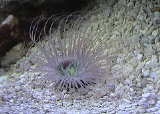
Tube-dwelling anemone
Encyclopedia
Tube-dwelling anemones or cerianthids look very similar to sea anemone
s, but belong to an entirely different subclass
of anthozoa
ns. They are solitary, living buried in soft sediments. Tube anemones live and can withdraw into tubes, which are made of a fibrous material, which is made from secreted mucus and threads of nematocyst-like organelle
s, known as ptychocysts.
Cerianthids have a crown of tentacles that consists of two whorls of distinctly different sized tentacles. The outer whorl consists of large tentacles that extend outwards. These tentacles taper to points and are mostly used in food capture and defence. The smaller inner tentacles are held more erect than the larger lateral tentacles and are used for food manipulation and ingestion.
:
Suborder Penicilaria contains the following genera
:
Sea anemone
Sea anemones are a group of water-dwelling, predatory animals of the order Actiniaria; they are named after the anemone, a terrestrial flower. Sea anemones are classified in the phylum Cnidaria, class Anthozoa, subclass Zoantharia. Anthozoa often have large polyps that allow for digestion of larger...
s, but belong to an entirely different subclass
Class (biology)
In biological classification, class is* a taxonomic rank. Other well-known ranks are life, domain, kingdom, phylum, order, family, genus, and species, with class fitting between phylum and order...
of anthozoa
Anthozoa
Anthozoa is a class within the phylum Cnidaria that contains the sea anemones and corals. Unlike other cnidarians, anthozoans do not have a medusa stage in their development. Instead, they release sperm and eggs that form a planula, which attaches to some substrate on which the cnidarian grows...
ns. They are solitary, living buried in soft sediments. Tube anemones live and can withdraw into tubes, which are made of a fibrous material, which is made from secreted mucus and threads of nematocyst-like organelle
Organelle
In cell biology, an organelle is a specialized subunit within a cell that has a specific function, and is usually separately enclosed within its own lipid bilayer....
s, known as ptychocysts.
Cerianthids have a crown of tentacles that consists of two whorls of distinctly different sized tentacles. The outer whorl consists of large tentacles that extend outwards. These tentacles taper to points and are mostly used in food capture and defence. The smaller inner tentacles are held more erect than the larger lateral tentacles and are used for food manipulation and ingestion.
Taxonomy
Suborder Spirularia contains the following generaGenus
In biology, a genus is a low-level taxonomic rank used in the biological classification of living and fossil organisms, which is an example of definition by genus and differentia...
:
- Family Botrucnidiferidae Carlgren, 1912
- Angianthula Leloup, 1964
- Atractanthula Leloup, 1964
- Botracnidifer
- Botruanthus
- Botrucnidiata Leloup, 1932
- Botrucnidifer
- Calpanthula
- Cerianthula Beneden, 1898
- Gymnanthula Leloup, 1964
- Hensenanthula
- Ovanthula
- Sphaeranthula
- Family Cerianthidae Milne-Edwards et Haime, 1852
- Anthoactis Leloup, 1932
- Apiactis Beneden, 1898
- Bursanthus
- Ceriantheomorphe
- Ceriantheopsis Carlgren, 1912
- Cerianthus Delle Chiaje, 1830
- Engodactylactis
- Isodactylactis
- Nautanthus
- Pachycerianthus Roule, 1904
- Paradactylactis
- Parovactis
- Peponactis
- Plesiodactylactis
- Sacculactis
- Solasteractis
- Synarachnactis Carlgren, 1924
- Syndactylactis
- Trichactis
Suborder Penicilaria contains the following genera
Genus
In biology, a genus is a low-level taxonomic rank used in the biological classification of living and fossil organisms, which is an example of definition by genus and differentia...
:
- Family Arachnactidae McMurrich, 1910
- Anactinia Annandale, 1909
- Arachnactis Sars, 1846
- Arachnanthus Carlgren, 1912
- Dactylactis van Beneden, 1897
- Isapiactis Carlgren, 1924
- Isarachnactis Carlgren, 1924
- Isarachnanthus Carlgren, 1924
- Isovactis
- Ovactis
- Paranactinia

